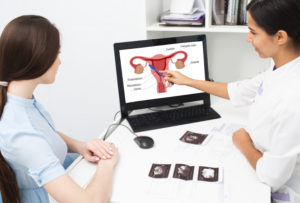By Iris Farrou
17 Oct, 2023
Health Conditions and Pregnancy, Pregnancy, Prevention, Procedures
amnioscentesis, amniotic fluid test, fetal lung test, genetic disorders, genetic predisposition, genetic testing, gestation, Healthy pregnancy, high risk pregnancy, pregnancy health conditions, tay-sachs disease, Ultrasound
 The majority of expectant parents want to ensure their baby is as healthy as possible. Along with pre-genetic tests that determine certain genetic traits or risks parents may pass to their offspring, prenatal testings are quite common. These help you carry a healthy pregnancy to term, and check in on the baby’s health. Amniocentesis is one of these prenatal tests: it diagnoses genetic disorders and other health issues in a fetus:
The majority of expectant parents want to ensure their baby is as healthy as possible. Along with pre-genetic tests that determine certain genetic traits or risks parents may pass to their offspring, prenatal testings are quite common. These help you carry a healthy pregnancy to term, and check in on the baby’s health. Amniocentesis is one of these prenatal tests: it diagnoses genetic disorders and other health issues in a fetus:
- Fetal infection can be determined through amniocentesis, along with other illnesses
- Fetal lung testing is rarely done, but if a delivery is planned to happen sooner than 39 weeks amniotic fluid helps see if a baby’s lungs are mature enough for birth
- Sometimes there is an amniotic fluid build-up in the uterus–polyhydramnios–and it is drained through amniocentesis
What is the procedure?
It is normal to be nervous about any medical procedure, much more so if you are pregnant! The goal of amniocentesis is to extract amniotic fluid from your uterus, and most procedures happen between 15-20 weeks of gestation. Here’s what you should expect on the day of your appointment:
- You will lie on your back, just like you would prepare for a routine ultrasound. That’s the first step, as the ultrasound will show where your baby is in your uterus that particular day and time.
- The ultrasound will remain on screen as your healthcare provider inserts a very thin needle through your stomach wall and into the uterus. The needle is removed swiftly as amniotic fluid is drawn into the syringe.
- There is no sedation or numbing used, and it is important that you stay still. Even after the needle is removed, the ultrasound will remain in use to monitor your baby’s heart rate.
- You may experience mild cramping during the procedure, and/or shortly after, but you should be able to resume your normal activities after the test.
When is it necessary?
As one of many prenatal testings, amniocentesis provides details on certain genetic conditions and issues that other procedures may not fully address. It can detect chromosomal, genetic disorders, or congenital disabilities such as down syndrome, Tay-Sachs disease, neural tube defects, and Rh disease.
If the results of a routine prenatal screening test are worrisome, your doctor may suggest amniocentesis to rule out another diagnosis. If you’ve had a pregnancy with a genetic condition, amniocentesis will look for that condition in your current pregnancy. If the parents are carriers of a genetic condition, or have a family history, amniocentesis shows whether your baby is affected by it. Unusual ultrasound findings are another reason for further testing. Babies born to people over 35 have a higher risk of chromosomal conditions, so if you’ve had a prenatal cell-free DNA screening that came back positive, amniocentesis will shed light into possible conditions.
Even if your doctor suggests amniocentesis, and explains why, the final decision is up to you; as with any healthcare issue, you always have the right to seek out other professional opinions!
More
By Iris Farrou
11 Mar, 2022
Pregnancy
Best gyns in Buffalo, Best OB practices in Buffalo, Best OBGYN Groups in Buffalo, Buffalo OB-GYN, Buffalo OBGYN, Chouchani MD, Healthy pregnancy, WNY OB-GYN, WNY Ob-gyn doctors, WNY OBGYN, women's health
 Many women utilize In Vitro Fertilization to achieve a healthy pregnancy, and discussions of the IVF process become more and more common. It is the most common form of assisted reproduction technology and has been around for approximately 40 years. It may sound daunting, as it does have a few steps and comes at a price, but what really is In Vitro Fertilization and what should you be looking out for if this is an option you are considering?
Many women utilize In Vitro Fertilization to achieve a healthy pregnancy, and discussions of the IVF process become more and more common. It is the most common form of assisted reproduction technology and has been around for approximately 40 years. It may sound daunting, as it does have a few steps and comes at a price, but what really is In Vitro Fertilization and what should you be looking out for if this is an option you are considering?
What is it?
The original definition means “fertilization in a glass,” where mature eggs are collected from the ovaries and are fertilized by the sperm in an incubator outside the body. Then, the healthiest embryo is transferred into the woman’s uterus. Though your specialist will determine what exactly is the best process for you, there are some standard steps in the IVF process, and a full cycle of IVF commonly takes 3-4 weeks. Sometimes the common steps are split into different parts, in which case the process may take longer.
The Steps
- Ovulation Induction: what marks the beginning of an IVF cycle is the use of artificial hormones to stimulate the production of multiple eggs. Though ovaries produce one egg during ovulation, more eggs are needed during IVF as some may not fertilize or develop normally after fertilization.
- Trigger Injection: before your eggs are ready for retrieval, you need 2-3 weeks of ovarian stimulation. Vaginal ultrasound or blood tests are then done to determine if the eggs are ready. Then, to assist the egg’s final maturation stage and loosening from the follicle wall, you will be given an injection of human chorionic gonadotrophin (hCG).
- Egg Retrieval: 34-36 hours after the injection your specialist will retrieve the matured eggs from your body. You may be lightly sedated during this 20-30 minute procedure and given some pain medication. On the same day, a semen sample will also need to be provided at your doctor’s office.
- Fertilization: this is the exciting part where the semen sample is washed and concentrated, and then added to the eggs approximately 4 hours after egg retrieval. They spend the night in an incubator and are checked the next day for fertilization. Usually, with a normal sperm sample, 60-70% of eggs will fertilize.
- Embryo Transfer: 2-3 days after egg retrieval you will be called back into your doctor’s office for the embryo to be placed in your uterus. The procedure is usually painless, and if this part of the procedure is successful, 6-10 days later you will have an implanted embryo on the lining of your uterus. This is called the Luteal Phase, followed by the Pregnancy Test about 14 days after the Embryo Transfer.
Risks
The most common risk when a woman is undergoing IVF is that there will not be a successful fertilization, or it will not lead to a successful pregnancy. Multiple cycles of IVF are not uncommon, but they can be financially stressful—as they range anywhere from 12k to 17k, according to the New York Times—and sometimes disheartening. Other risks include multiple pregnancies, ectopic pregnancy, miscarriage, premature delivery, and birth defects—among others.
More
By Iris Farrou
11 Feb, 2022
Women's Health
Best gyns in Buffalo, Best OB practices in Buffalo, Best OBGYN Groups in Buffalo, Buffalo OB-GYN, Buffalo OBGYN, Chouchani MD, Healthy pregnancy, Preeclampsia, WNY OB-GYN, WNY Ob-gyn doctors, WNY OBGYN, women's health, women's health tips
 As much joy as a pregnancy brings, there are also a lot of worries that accompany it. While preeclampsia may summon dated references like Lady Sybil’s death on Downton Abbey, it still affects women today. According to the CDC, 1 in 25 pregnancies in the United States are affected by preeclampsia—the sudden elevation of the mother’s blood pressure after the 20th week of pregnancy.
As much joy as a pregnancy brings, there are also a lot of worries that accompany it. While preeclampsia may summon dated references like Lady Sybil’s death on Downton Abbey, it still affects women today. According to the CDC, 1 in 25 pregnancies in the United States are affected by preeclampsia—the sudden elevation of the mother’s blood pressure after the 20th week of pregnancy.
What is it and what are the causes?
Preeclampsia usually begins after the 20th week of pregnancy, with some rare cases of postpartum preeclampsia. It is characterized by high blood pressure, as well as damage to the liver and kidneys. There may also be protein in the women’s urine and low levels of platelets. For a preeclampsia diagnosis, the mother’s blood pressure during pregnancy needs to be persistent and other symptoms of organ damage, low platelets, fluid in the lungs, and/or signs of brain trouble need to be present.
The causes of preeclampsia have not yet been precisely identified. However, potential causes include genetic factors, blood vessel problems, and chronic hypertension, as well as metabolic diseases or autoimmune disorders. There are some known risk factors that may increase the chances of preeclampsia, such as:
- history of preeclampsia in your family
- preeclampsia in a previous pregnancy
- having a multiple pregnancy or becoming pregnant via IVF
- being over the age of 40
- having obesity
- being pregnant for the first time
How Can it be Treated?
To receive a diagnosis and treatment, watch out for the following symptoms:
- signs of kidney problems and excess protein in your urine
- severe headaches and changes in vision
- upper abdominal pain
- nausea or vomiting, as well as shortness of breath
Some symptoms may go unnoticed, such as sudden weight gain and swelling, since they are normal symptoms of a pregnancy, so watch out for a combination of symptoms and attend all your prenatal appointments to ensure you and your baby’s safety.
With preeclampsia, you are at increased risk of seizures, stroke, severe bleeding, and placental abruption. As such, the most effective treatment is delivery. Possible medications may include antihypertensives to help lower your blood pressure, corticosteroids that can temporarily improve liver and platelet function, as well as anticonvulsant medications to prevent seizures. Severe cases of preeclampsia may require you to be hospitalized, but by far the most effective treatment is delivery of the baby. Be wary of the traditional suggestion of “bed rest,” as in this case it can actually be more harmful since it increases the risk of blood clots.
More
By Iris Farrou
30 Oct, 2021
Pregnancy
Best gyns in Buffalo, Best OB practices in Buffalo, Best OBGYN Groups in Buffalo, Buffalo OB-GYN, Buffalo OBGYN, Chouchani MD, Healthy pregnancy, WNY OB-GYN, WNY Ob-gyn doctors, WNY OBGYN, women's health

Even though many high school teachers had teenagers convinced they could get pregnant simply by having sex (and there’s definitely merit to that), in adulthood things can get a little more complicated. If you and your partner are trying to get pregnant through natural insemination, there are a few factors you may want to take into consideration in order to increase your chances of conceiving.
First Things First would be to become familiar with your cycle so you can determine whether it is a regular one (every 28 days) or an irregular one (shorter or longer). That will also help you find out when you may be ovulating. You can use apps to help you track your cycle, as well as your symptoms on the days leading up to menstruation and after. You can also notice symptoms such as an increase in body temperature and more vaginal secretions on the days leading up to your ovulation.
Knowing when you ovulate means you can determine your most fertile days each month. On a regular cycle, this would be 2 weeks before you get your period. It can be a little more difficult to predict that on an irregular cycle, but it is usually 12-16 days before you menstruate. You can better determine this with the help of home ovulation prediction kits, which test urine for luteinizing hormone, a substance whose levels increase each month during ovulation.
The short fertility window spans 5 days before ovulation begins and the 1st day of it, and that’s when the chances of conceiving are even higher. Many couples wonder if it would be best to have sex every day during that window, and the short answer is: yes! The highest rates of pregnancy occur in coupled who have sex regularly, and near or on the time of ovulation.
Knowing the medical information about your body is definitely helpful, as is learning to recognize where your cycle is and being in tune with it. If you have an IUD, tied tubes, or feel that you need assistance in planning a pregnancy, you can always consult an expert and be in touch with your doctor. However, you may also want to take into consideration some of the following factors that contribute to conceiving:
- Maintaining a healthy weight can help, as excess body fat has been found to produce more estrogen, which can interfere with ovulation. Underweight women can also suffer from irregular periods or could also stop ovulating.
- Eating healthy foods that contribute to preparing a woman’s body for pregnancy by providing adequate calcium, protein and iron, and folic acid. Try to avoid foods that are high in mercury, as it has been found to enter women’s bloodstream and has been linked to negatively affecting a baby’s development.
- Cutting down on alcohol and smoking are very important factors in not only maintaining your general health, but also ensuring your body is a healthy home for a fetus.
Keep in mind that stress can be a huge factor when trying to conceive. Lots of couples face heightened stress and anxiety once they embark on the journey of getting pregnant, which can lead not only to intimacy issues, but also affect a woman’s cycle and throw it all off-balance. Remember this may not be an easy process and being supportive of each other as well as seeking help when needed are key to remaining healthy.
More
By Iris Farrou
19 Aug, 2021
Pregnancy
Best gyns in Buffalo, Best OB practices in Buffalo, Best OBGYN Groups in Buffalo, Buffalo OB-GYN, Buffalo OBGYN, Chouchani MD, Healthy pregnancy, WNY OB-GYN, WNY Ob-gyn doctors, WNY OBGYN, women's health, women's health tips

Back pain during pregnancy is one of the most common causes of pain and discomfort. In later pregnancy, the pain can lead to insomnia, fatigue, and women opting for early birth inductions. While many medical professionals and journals label back pain during pregnancy as a “minor” symptom, anyone who has experienced it will tell you that is an understatement.
If you’ve never heard of an Ozzlo Pillow, it’s a wedge-shaped pillow designed to prevent or alleviate both back-aches and back-ache induced insomnia. The wedge pillow is placed under the abdomen while laying on your side, providing great support and relief. An overwhelming 87% of women experience back pain in the last few weeks of gestation. Medical studies found that wedge-shaped pillows do indeed dramatically reduce pain and allow for a better night’s rest. Even using a regular pillow in the same placement can be almost as effective.
Aside from medical studies with the wedge pillow, here’s a list of tried and tested different support pillows that can make pregnancy an even better experience:
- U-Shaped body pillows rank first among most pregnant women, who praise their size and shape-adapting ability, reporting that they relieve most of the pain they feel and reduce discomfort. There are even some U-Shaped body pillows designed specifically for pregnancy with a special space for abdominal placement.
- Memory Foam Body Pillows also do wonders for forming to parts of your body, providing support and pressure relief. This is a slightly more cost-effective option that provides the same level of pain alleviation as other—more specialized and expensive—orthopedic pillows.
- Yana Pillows are similar to U-Shape Pregnancy pillows and have a special filling that provides luxurious relief for both back and side-sleeping pregnant women. It shapes itself on the curves of the body, so when using it your body does not have to inconvenience itself. Rather, the pillow adjusts to provide the support you need and relieve you from the aches of pregnancy.
- The Belly-Bandit is a 3-piece and OB-GYN-designed pillow, best for helping pregnant women sleep on their side to achieve optimal blood flow and oxygen to their baby. As it is a more versatile pillow, its great advantage is that it can be used by women prior to pregnancy so that they get accustomed to sleeping on their sides.
The advantages of pregnancy/orthopedic pillows go beyond pain alleviation: relieving the pain is great, but these pillows also prevent the use of pain relievers, reduce heartburn, avoid orthopedic medical intervention in the long run, prevent postnatal back and sciatic nerve issues, and reduce stress levels. Feel free to consult your doctor if you’re unsure which support pillow would best fit your needs, as you may need different support during the different stages of pregnancy.
More
By Iris Farrou
21 Jun, 2021
Pregnancy
Best gyns in Buffalo, Best OB practices in Buffalo, Best OBGYN Groups in Buffalo, Buffalo OB-GYN, Buffalo OBGYN, Chouchani MD, Healthy pregnancy, WNY OB-GYN, WNY Ob-gyn doctors, WNY OBGYN, women's health, women's health tips
 Thyroid diseases affect hormone levels and may cause overall hormonal imbalances that ultimately can have an impact on a woman’s fertility. Additionally, women have been found to develop either hyperthyroid or hypothyroid during pregnancy. However, it is untreated thyroid diseases that may have more of a negative impact on a pregnancy and not medicine-regulated thyroid conditions.
Thyroid diseases affect hormone levels and may cause overall hormonal imbalances that ultimately can have an impact on a woman’s fertility. Additionally, women have been found to develop either hyperthyroid or hypothyroid during pregnancy. However, it is untreated thyroid diseases that may have more of a negative impact on a pregnancy and not medicine-regulated thyroid conditions.
What is the difference?
Hyperthyroidism: refers to an overactive thyroid, when your thyroid gland produces too much of the hormone thyroxine. It usually heightens your metabolism, causing an irregular fast heartbeat and often accompanied by unplanned weight loss.
Hypothyroidism: as the name suggests, this is when your thyroid gland is less than regularly active, thus producing less of the hormone thyroxine than your body needs. It may initially not cause any symptoms, but if left untreated hypothyroidism may lead to obesity, infertility, and heart disease.
Thyroid Risks & Pregnancy
You may be at a higher risk for a thyroid condition during pregnancy if:
- You are currently being treated for a thyroid condition.
- Have already had a thyroid condition or have had a child with a thyroid condition.
- Have a family history of thyroid autoimmune conditions, such as Graves’ disease or Hashimoto’s disease.
- Have an autoimmune condition or Type 1 diabetes.
Hyperthyroid and Pregnancy
Untreated or inappropriately treated hyperthyroidism can lead to the following issues during pregnancy, especially affecting the baby:
- Premature birth, before the 37th week of pregnancy.
- Low birthweight, with the baby being born under 5 pounds.
- Goiter, the abnormal enlargement of the thyroid gland as well as general thyroid problems.
- Miscarriage or stillbirth.
Hypothyroid and Pregnancy
Some of the problems untreated hypothyroid can cause for the baby are the same as in the case of untreated hyperthyroid—such as thyroid problems, miscarriage or stillbirth—but there are a few that are different:
- Problems with nervous system developmenta and brain growth, especially when untreated hypothyroid happens during the first trimester.
- Infantile myxedema, which is linked to severe hypothyroid can lead to dwarfism (when an adult person is less than 4ft tall) as well as lower-than-average intelligence and a lack of skills necessary for daily life.
Thyroid Medicine
Whether you are experiencing hyperthyroid or hypothyroid, thyroid medicine is meant to balance thyroid hormones in your body and keep them at the right level. If you are taking thyroid medicine and planning to become pregnant, consult with your doctor for possible adjustments. If you are taking medicine and become pregnant, do not stop taking your medication—as untreated thyroid problems lead to more severe issues than taking the medicine—but do get in contact with your doctor as soon as possible to ensure your and your baby’s health.
Remember that since thyroid diseases are a hormonal imbalance, lack of medicine and proper treatment is what leads to severe, or even fatal, issues during pregnancy; thyroid medication is not likely to harm an expectant mother or her baby.
More
 Any expectant mother’s goal is to deliver a safe and healthy baby, and the work to achieve that begins as soon as a woman realizes she is pregnant. From prenatal vitamins to diet changes, and more that are discussed here, women employ a variety of methods to boost their immune system during pregnancy. Did you know that your body actually lowers its immune defenses upon pregnancy to allow the fetus to grown? As a result, of course, your immune system becomes weaker and needs some extra support. This is especially important now, when COVID-19 poses an extra threat to individuals with a weakened immune system.
Any expectant mother’s goal is to deliver a safe and healthy baby, and the work to achieve that begins as soon as a woman realizes she is pregnant. From prenatal vitamins to diet changes, and more that are discussed here, women employ a variety of methods to boost their immune system during pregnancy. Did you know that your body actually lowers its immune defenses upon pregnancy to allow the fetus to grown? As a result, of course, your immune system becomes weaker and needs some extra support. This is especially important now, when COVID-19 poses an extra threat to individuals with a weakened immune system.
Immune Support Techniques
- Prenatal Vitamins: During pregnancy, not only do you have a weakened immune system, but you also need to be careful with your diet. This can often make it difficult to have a healthy intake of necessary nutrients, so taking prenatal vitamins recommended by your doctor is a good way to ensure you are boosting your immune system and your overall health. In fact, it’s ideal to get on prenatal vitamins when you start trying to conceive.
- Hydration: Staying hydrated is a good way to avoid illness and to help alleviate symptoms of it if you get sick. Our bodies need water, so extra intake of water ensures that your immune system runs effectively. Though there can be other sources, avoid drinks high in sugar or caffeinated beverages.
- Diet: A diet high in fruits, vegetables, and proteins has the ability to naturally boost your immune system and help you get better if you get sick. Avoid foods with high sugar percentages and other carbohydrates. This way, you are ensuring you are consuming the necessary vitamins and minerals.
- Rest: Though self-explanatory, a good night’s sleep goes a long way in boosting your immune system and in making sure your body is getting enough energy to stay healthy and to sustain a growing baby.
- Humidifier: Not only can humidifiers help alleviate cold symptoms, they also keep the air pleasantly moist and generally cleaner.
Pregnancy and COVID-19
Because pregnancy can cause a lower immune system, it follows that the risk of contracting COVID-19 is higher. At this moment, the World Health Organization does not specify different protection measures against COVID-19 for pregnant women, but it does caution to the higher risk the virus poses to pregnant women.
As is recommended:
- Wash your hands frequently with soap and water or with an alcohol-based hand rub.
- Keep recommended space between yourself and others and wear a fabric mask.
- Avoid crowded spaces.
- Avoid touching your eyes, nose, and mouth.
- Practice respiratory hygiene by covering your mouth and nose with your elbow should you need to sneeze.
More
By Iris Farrou
30 Dec, 2020
Pregnancy
Best gyns in Buffalo, Best OB practices in Buffalo, Best OBGYN Groups in Buffalo, Buffalo OBGYN, Chouchani MD, Healthy pregnancy, WNY OB-GYN, WNY Ob-gyn doctors, WNY OBGYN, women's health
 There comes a time at every pregnancy when the delivery of the baby becomes the issue at hand; many mothers have a choice on whether to go through a natural birth—also referred to as vaginal birth—or request a Caesarian section, most commonly known as C-section. Sometimes a C-section is necessary, especially in cases of medical concerns for the health of the baby or the mother, but when faced with the option it is a wise idea to be informed of the differences between the two methods of delivery, as well as their respective risks and complications.
There comes a time at every pregnancy when the delivery of the baby becomes the issue at hand; many mothers have a choice on whether to go through a natural birth—also referred to as vaginal birth—or request a Caesarian section, most commonly known as C-section. Sometimes a C-section is necessary, especially in cases of medical concerns for the health of the baby or the mother, but when faced with the option it is a wise idea to be informed of the differences between the two methods of delivery, as well as their respective risks and complications.
Overview
C-sections are a surgical procedure to deliver the newborn, and it takes place either when requested by the mother in lieu of natural birth, or when medical conditions make it necessary. Sometimes a C-section is pre-planned, while other times it may become necessary during labor. They are not as common as natural births, but the following conditions may make a C-section necessary for the safety of both the mother and the baby:
- General health medical concerns for the newborn
- Delivery of more than one baby
- Maternal infections or conditions, such as diabetes
- Problems with the placenta
- Delivery of a larger baby
- A labor that is not progressing in a timely manner, making it unsafe to continue naturally
A natural birth is a vaginal delivery, and it may take place with or without medical assistance for the pain. Natural births usually require a shorter hospital stay and have a faster recovery period. If the mother chooses to have a medical intervention to assist with a natural birth, this may be one of the following:
- Using Pitocin to induce labor
- An incision to help with the delivery of the baby without tearing the skin
- Artificially breaking the water, which would mean a rupture of the amniotic membrane
- A vacuum extraction
Procedure and Healing
Caesarean Delivery
In the case of a Caesarean section, the surgical procedure in general takes about 45 minutes. An incision is made through your abdomen and uterus to remove the baby, usually in the lower part of your uterus. As it is an operation, mothers may be given general anesthesia or an epidural block, where you will be awake during the procedure but not feel the lower part of your body.
The doctor cuts the umbilical cord, removes the placenta and closes the incision while the nurses may need to check the baby and clear their airway before they return it to the mother. Unlike natural birth, it may be a few minutes before the mother is united with her baby after a C-section.
As it is a surgery, recovering from a C-section will be similar to that of any kind of operation. There is a two to four day required stay at the hospital, and pain is to be expected when moving around or getting in and out of bed. The scar from the procedure may be itchy or painful in the first few weeks, like with any surgical scar, and cramps or discharge for about four to six weeks are natural.
Vaginal Delivery
A vaginal delivery happens in the hospital or a birthing center, and sometimes at home. In some cases, mothers opt for an epidural to numb the pain. There are three stages to this procedure: early, active, and transitional. Periodically, your cervix will be measured to determine whether you are fully dilated.
A full dilation is when the cervix is at 10 cm, when it is time to push. As the baby moves down the birth canal, the medical team assists with the delivery and uniting the newborn with the mother immediately. While the baby may be out, more contractions to extract the placenta are expected. Unlike a C-section, natural delivery has no specific timeframe and may take hours.
Takeaway
When the time comes to consider the safest option for you and your baby, always consult with your medical professional or your doctor. The safest choice depends on your medical history.
More

Even though they are not very common, some women are born with an abnormal uterus, including a defect in the size, shape, or structure of the uterus. The two most common types are called heart-shaped uterus and tipped uterus.
What is commonly referred to as a heart-shaped uterus is actually a “bicornuate uterus.” It occurs when the fallopian tubes come together on top of the main uterine cavity and form a shape that resembles a heart. Romantic as this may sound, uterine irregularities may cause complications during pregnancy.
A tipped uterus (officially referred to as a retroverted uterus) is a type of uterus that tilts in a backward position at the cervix instead of forward. A tipped uterus can either be a variation of pelvic anatomy by birth, or it can develop as women mature. Less romantic-sounding than the heart-shaped uterus, a tipped uterus may also be the result of pelvic scarring or adhesions.
Symptoms
Neither condition has particularly noticeable symptoms, and both are usually determined when women get either a pelvic exam or an ultrasound. Common symptoms of an abnormal uterus include the following:
| Heart-Shaped Uterus |
Tipped Uterus |
| Irregular vaginal bleeding |
Lower back pain during intercourse |
| Repeated miscarriages |
Trouble inserting tampons |
| Painful periods and abdominal discomfort |
Increased urinary frequency and UTIs |
| Pain during intercourse |
Protrusion of the lower abdomen |
Keep in mind that in the case of a heart-shaped uterus the symptoms may not feel out of the ordinary, as you have most likely had it your whole life.
Causes
Women with heart-shaped uteri are born this way, so the cause is simply the way the uterine cavity and fallopian tubes are shaped. However, a tipped uterus is not always a birth defect and its possible underlying causes warrant attention:
- Endometriosis: endometrial scar tissue or adhesions may cause the uterus to stick in a backward position.
- Fibroids: uterine fibroids can cause the uterus to tilt backward.
- Pelvic Inflammatory Disease (PID): if left untreated, PID can cause scarring that has a similar effect to endometriosis.
- History of pelvic surgery or prior pregnancy: in both, or either, case the ligaments that hold the uterus in place can become stretched/ scarred and cause the uterus to tilt backward.
Pregnancy and Fertility
In the case of a heart-shaped uterus, the chances of conceiving do not become less, nor is your fertility affected. It has, however, been suggested that this uterine shape is more common in women who are infertile.
A heart-shaped uterus increases the chances of a miscarriage in the later stages of a pregnancy, or an early delivery of the baby. These cases are connected to either reduced uterine capacity or irregular uterine contractions. Additionally, babies born to mothers with a heart-shaped uterus are four times more likely to develop birth defects. It is also more likely that you will have to give birth via a C-section.
Though a tipped uterus does not affect a woman’s ability to conceive, it is often connected to other conditions that may lead to fertility issues. These include endometriosis, pelvic inflammatory disease (PID) and fibroids. When necessary, infertility treatments such as intrauterine insemination (IUI) or in vitro fertilization (IVF) assist women with these diagnoses to achieve pregnancy.
More
 Exercise is the best way to help your body cope with the physical changes during pregnancy. Even if you did not exercise before you were pregnant, it’s a great time to start. Experts recommend 30 minutes of moderate-intensity exercise at least five days a week. This recommendation is actually the same for all adult women. However, exercise during pregnancy is especially important because it can reduce back pain and ease constipation, bloating, and swelling. Regular exercise also boosts your mood and energy, while helping you sleep better. If that’s not enough, it will also help your body prepare for labor and ward off excess baby weight.
Exercise is the best way to help your body cope with the physical changes during pregnancy. Even if you did not exercise before you were pregnant, it’s a great time to start. Experts recommend 30 minutes of moderate-intensity exercise at least five days a week. This recommendation is actually the same for all adult women. However, exercise during pregnancy is especially important because it can reduce back pain and ease constipation, bloating, and swelling. Regular exercise also boosts your mood and energy, while helping you sleep better. If that’s not enough, it will also help your body prepare for labor and ward off excess baby weight.
First Trimester
- Walking is the easiest way to get active. You can get started right away—all you need is a decent pair of sneakers. A moderate pace of about 1 mile every 20 minutes will raise your heart rate, without putting too much strain on muscles and joints.
- Yoga is another exercise that needs minimal equipment—all you need is comfortable clothes and a gym mat. Through a combination of stretching, aerobic-type exercises, and deep breathing, yoga will tone your body, while also resetting your mind and reducing overall stress.
- Water aerobics requires a pool or gym membership, but it’s a great way to get active because it’s low impact. Swimming classes are especially gentle on joints, legs, and ankles.
- Jogging and running are goods way to get your blood pumping, but they should be reserved for experienced athletes. Pregnancy is not a good time to start running for the first time.
- Strength training helps build muscles in your arms to prepare for carrying the baby around. When pregnant it’s advised to avoid excessive weight and exercises where you are lying on your back.
- Low-Impact Aerobics are still okay in your first trimester, but can be more straining than other options. If you are already active with aerobics, it’s safe to keep it up as long as you are being careful. It’s always best to choose aerobics classes or videos geared toward pregnant women.
Second Trimester
While you may need to adjust your habits based on your changing body, there is no reason to cut back on exercising during your second trimester. In fact, it’s highly recommended to continue getting 30 minutes of moderate exercise each day.
Even more so than the first trimester, choose low impact exercises such as walking, yoga, and swimming. Yoga is still a great exercise to help reduce stress, calm your mind, and strengthen your body. However, in the second trimester, it’s best to avoid yoga poses where you are lying on your back for more than a moment or two because the weight of your enlarging uterus could compress major blood vessels and restrict circulation to you and your baby. Motionless standing, like tree pose, should be avoided as it can restrict blood flow.
Third Trimester
For the final trimester, you should focus solely on low-impact, easy exercises. Keep up your routines and continue doing what has felt good during your pregnancy so far. Walking, yoga, and water aerobics are great exercises for your third trimester.
Intense strength training such as ab workouts, push-ups and planks should be avoided. It’s also best to avoid exercises where your balance is challenged by using only one leg at a time.
Takeaway
Before you begin any exercise regimen while pregnant, talk to your OBGYN. They can help you build an ideal fitness plan based on your current fitness levels, and any possible unique risk factors.
More
 The majority of expectant parents want to ensure their baby is as healthy as possible. Along with pre-genetic tests that determine certain genetic traits or risks parents may pass to their offspring, prenatal testings are quite common. These help you carry a healthy pregnancy to term, and check in on the baby’s health. Amniocentesis is one of these prenatal tests: it diagnoses genetic disorders and other health issues in a fetus:
The majority of expectant parents want to ensure their baby is as healthy as possible. Along with pre-genetic tests that determine certain genetic traits or risks parents may pass to their offspring, prenatal testings are quite common. These help you carry a healthy pregnancy to term, and check in on the baby’s health. Amniocentesis is one of these prenatal tests: it diagnoses genetic disorders and other health issues in a fetus:








